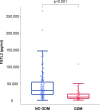First-trimester follistatin-like-3 levels in pregnancies complicated by subsequent gestational diabetes mellitus
- PMID: 20007937
- PMCID: PMC2827528
- DOI: 10.2337/dc09-1745
First-trimester follistatin-like-3 levels in pregnancies complicated by subsequent gestational diabetes mellitus
Abstract
OBJECTIVE To determine whether maternal levels of follistatin-like-3 (FSTL3), an inhibitor of activin and myostatin involved in glucose homeostasis, are altered in the first trimester of pregnancies complicated by subsequent gestational diabetes mellitus (GDM). RESEARCH DESIGN AND METHODS This was a nested case-control study of subjects enrolled in a prospective cohort of pregnant women with and without GDM (> or =2 abnormal values on a 100-g glucose tolerance test at approximately 28 weeks of gestation). We measured FSTL3 levels in serum collected during the first trimester of pregnancy. Logistic regression analyses were used to determine the risk of GDM. RESULTS Women who developed GDM (n = 37) had lower first-trimester serum levels of FSTL3 compared with women who did not (n = 127) (median 10,789 [interquartile range 7,013-18,939] vs. 30,670 [18,370-55,484] pg/ml, P < 0.001). When subjects were divided into tertiles based on FSTL3 levels, women with the lowest levels demonstrated a marked increase in risk for developing GDM in univariate (odds ratio 11.2 [95% CI 3.6-35.3]) and multivariate (14.0 [4.1-47.9]) analyses. There was a significant negative correlation between first-trimester FSTL3 levels and approximately 28-week nonfasting glucose levels (r = -0.30, P < 0.001). CONCLUSIONS First-trimester FSTL3 levels are associated with glucose intolerance and GDM later in pregnancy.
Figures



References
-
- Metzger BE, Buchanan TA, Coustan DR, de Leiva A, Dunger DB, Hadden DR, Hod M, Kitzmiller JL, Kjos SL, Oats JN, Pettitt DJ, Sacks DA, Zoupas C: Summary and recommendations of the Fifth International Workshop-Conference on Gestational Diabetes Mellitus. Diabetes Care 2007;30(Suppl. 2):S251–S260 - PubMed
-
- Catalano PM, Tyzbir ED, Wolfe RR, Calles J, Roman NM, Amini SB, Sims EA: Carbohydrate metabolism during pregnancy in control subjects and women with gestational diabetes. Am J Physiol 1993;264:E60–E67 - PubMed
-
- Buchanan TA, Xiang A, Kjos SL, Watanabe R: What is gestational diabetes? Diabetes Care 2007;30(Suppl. 2):S105–S111 - PubMed
-
- Kim C, Newton KM, Knopp RH: Gestational diabetes and the incidence of type 2 diabetes: a systematic review. Diabetes Care 2002;25:1862–1868 - PubMed
-
- Rauh-Hain JA, Rana S, Tamez H, Wang A, Cohen B, Cohen A, Brown F, Ecker JL, Karumanchi SA, Thadhani R: Risk for developing gestational diabetes in women with twin pregnancies. J Matern Fetal Neonatal Med 2009;22:293–299 - PubMed
Publication types
MeSH terms
Substances
Grants and funding
LinkOut - more resources
Full Text Sources
Other Literature Sources

